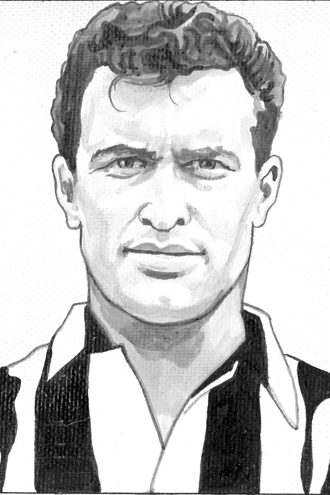
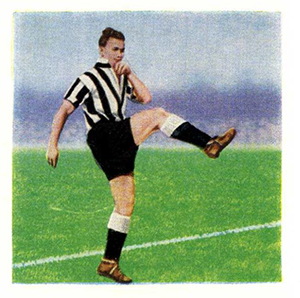
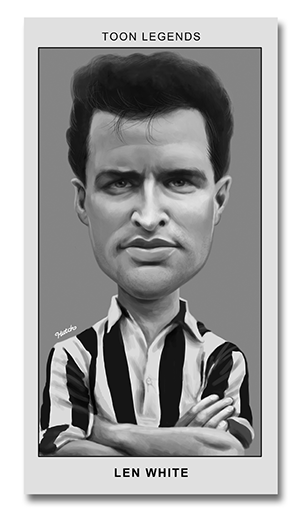
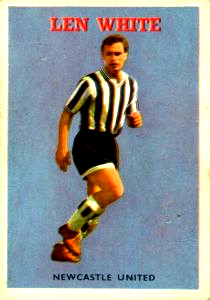
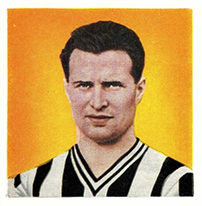
| Birth | 23/03/30 | Skellow | Yorkshire |
| P/H/W | Forward | 5ft 7in | |
| Jnd | 19/02/53 (22) | Rotherham | £12,500 |
| Deb | 21/02/53 (22) | Liverpool (H) | Div 1 |
| Left | 02/62 (32) | Huddersfield | |
| App/Gls | 270 | 153 |
Len White spent almost exactly nine years on Tyneside and with 153 goals is the third top scorer in the club’s history. He joined from Rotherham in February 1953 and was sold to Huddersfield in February 1962, much to the dismay of the supporters.
Although Len was an important member of the squad in his first five seasons, fame and acclaim would come relatively late. His career on Tyneside only really took off in the 1957/58 season from when he became a true Gallowgate hero.
During the fifties United liked to play with contrasting wingers and with Bobby “dazzler” Mitchell on the left they usually had a direct, speed-merchant on the right. With excellent speed off the mark, the ability to challenge and beat opponents and an old-fashioned efficiency to cross long balls, Len fitted the brief perfectly.
He had played outside-right at Rotherham and in his first five seasons on Tyneside this was the position he was usually used in, although he also turned out at centre-forward, inside-right and outside-left.
Enthusiasm, high-speed and opportunism were his watchwords. A whole-hearted player who was quick to seize an opening and put plenty of punch into his work. Len exhibited excellent close-control and could pass the ball with great skill.
He was a versatile forward, terrier like and endowed with any amount of fighting spirit and although he was only 5’ 7” he was stocky and determined.
Possessing a cracking shot in both feet, he had the sharpness, composure and strength to score from short or long distance. An effortless finisher, his goal per game ratio was decent in those first five seasons.
At the time the directors would continually swop both players and their positions and Len, although normally at outside-right, was used in all the forward slots except inside-left.
As a result Len, like many others at the time, struggled to retain his place in the side. Not surprisingly this impacted his confidence and at one time he had a tendency to withdraw into his shell if he was struggling.
He did make the side for the FA Cup Final in 1955 when Reg Davies dropped out with laryngitis and it was his corner that Milburn headed in for United’s quick-fire opener. The winner’s medal satisfied Len’s first career ambition.
As the decade wore on Len began to be used more and more as a centre-forward and adapted his style accordingly. His ball control and distribution were excellent and he led the line brilliantly. A roaming centre, Jackie Milburn once noted that “his foraging and wandering into open spaces makes it easy for his team mates to find him”.
And, despite his small size, Len had a tremendous leap and strong neck muscles which enabled him to beat a big man and head for goal. A significant number of his goals on Tyneside were headers.
1957/58 was the first season in which Len was used primarily as a centre-forward and it proved to be the turning point in his career. After a poor start in which he scored only 2 goals in 13 games he appeared to be lacking in spirit and confidence. Len was dropped for one match at Leeds in mid-December, but when he returned against West Brom he scored twice, hit the woodwork three times and had a goal disallowed in a sensational display.
This match kick-started his season and as his confidence grew he became a Tyneside hero, a hard-working, alert spearhead with explosive pace and a tremendous goal-getting record.
His performances subsumed the best of his wing style into his centre-forward play using his speed, balance and dribbling skill, allied with a deceptive body swerve.
Len would like to sit relatively deep and make spectacular, long, mazy runs through the middle, invoking the Gallowgate roar once reserved for Jackie Milburn’s dashes. Add in drives of dynamite and dynamic leaps in the air and you had performances of dazzle, thunder and flash.
Bob Stokoe said at the time that: “I have always said that Len would be a great player if he would only believe in himself”. The fans certainly did, with favourable comparisons being made to United greats Albert Shepherd and Hughie Gallacher.
In the home game against Manchester City in 1957/58 he scored an incredible goal. He set off on a solo dribble from 15-yards inside his own half, beat four players who were deceived by the pace of his movement and slammed the ball past the advancing Trautmann. Reporter Ken McKenzie called it “a goal of a lifetime” and suggested it was “one which Jackie Milburn, even the late Hughie Gallacher could have envied.”
Not surprisingly because of his size his ability to snap up openings was most evident when he received good supply along the ground. Inside-right George Eastham, who had a flair for prodding quick passes through the middle just to his liking, was a great help. And when Welsh international inside-left Ivor Allchurch joined United had a triumvirate of players who dovetailed together brilliantly.
On his day many judged him to be the most effective centre-forward in the land and he appeared twice for the Football League against the Irish and Scottish League teams.
Len was selected ahead of Brian Clough when Nat Lofthose pulled out due to injury for the game against the Irish League in 1957/58. Manager Mitten said: “It is great news and a well deserved award and all the lads at Gallowgate are delighted. We all know he will be an outstanding success. This is just the opportunity he has wanted.”
And Len certainly lived up to his billing, scoring a stunning seven-minute hat-trick in front of the Kop in a 5-2 victory. ITV received a lot of criticism for only broadcasting part of the game using their telefilm facilities, capturing only two goals and none of Len’s.
But although Len was often strongly tipped for a full international cap, the call-up never came and he didn’t achieve his second career ambition. It was said at the time that Len was one of the best uncapped centre-forwards in the game, with Milburn claiming he was the best.
His lack of height was probably a factor as it made him more reliant on good service from the inside-forwards. Some believed he was too much of an individualist who was at his best in quick breaks which gave him the space and opportunity to utilise his brilliant ball play. Perhaps lack of confidence was also a factor and he unfortunately tended to have poor games when he was watched by England manager Walter Winterbottom.
In 1960/61 Len recovered from a slow start and was scoring so regularly that he had every chance of surpassing Hughie Gallacher record number of League goals scored in a season. But in the last seconds of the match at leaders Tottenham on the 22nd March hard-man Dave Mackay’s heavy challenge badly tore the ligaments in his left ankle.
Although he had hoped to be fit for the new season, his ankle was still sore after a practice game and it was revealed that he was not expected to return until October and would receive “electrical treatment.” Miraculously, within days, he was deemed fit enough to play.
Len was not happy about being rushed back and struggled to regain his form. Clubs started to make bids for him and although United kept rebuffing them, journalist Stan Bell claimed they were prepared to sell. In February United signed centre-forward Barrie Thomas and Len was used in part-exchange for Huddersfield inside-forward Jimmy Kerray.
Although Jackie Milburn once said “Len is one of those fellows who doesn’t say much, he prefers to go on the field to do things”, George Eastham later referred to him as “the joker” at the club.
At Rotherham he worked down the pit and when he joined United he became employed as a platelayer at Burradon Colliery where he continued to work until March 1956. Shortly after he joined Newcastle United he received a notice about National Service and had to tell the Labour Exchange that he was employed in the mines.
Len's hobbies were golf and cricket and his favourite sportsman was Peter May.
Len was the youngest son of a footballing family. His father played and so did three of his brothers. In 1955, Jack was Bristol City's right-half and captain, Albert played with Aldershot and Freddie with Bradford.
He started work down the pit at Doncaster from the age of 16 and played for Upton Colliery FC. He was soon engaged by Rotherham where he was taught wing play by Mark Hooper, the old Sheffield Wednesday outside-right.
Len was a reasonably regular starter at outside-right for Rotherham and played for an FA XI against the Army and the RAF.
Rotherham outside-right Jack Grainger and his deputy Len White had both impressed Newcastle and when a bid of £30,000 for Grainger was rejected United offered £12,500 for Len. He signed in February and made his debut a couple of days later. He was retained for the next game, but was then struck down with gastric influenza.
Milburn, Foulkes, Walker, Monkhouse all vied with Len for the outside-right berth and he got limited opportunities. He also got a couple of outings at centre-forward including the last home game against Arsenal when his performance impressed everyone. Len scored his first goal in the FA Cup tie at Wigan.
With Foulkes and Walker departing there were more opportunities on the right for Len, but it was when he played at centre-forward that he earned most plaudits. An injury to Monkhouse at the start of the season enabled him to have a run in the side at Number 9 and he did very well, particularly when he scored four against Villa in September, three of which were headers. In the second half of the season he played mainly at outside-right and new manager Duggie Livingstone selected him there for the Cup Final rather than Jackie Milburn only for the director’s to overturn his decision. However Reg Davies went down with laryngitis which meant they both played and Len’s corner was headed in by Milburn for United’s early strike. His goal return was decent and he finished as third-top scorer.
Len had lost a lot of work at the pit due to United’s 1955 Cup run and the summer tour of Germany and as a result missed the start of pre-season training because he was working full-time. He was once more usually used at outside-right or centre-forward, but was used in every position across the front-line except inside-left, playing in half the games. Len stopped his pit working in March.
Now he had full concentration on his football it was thought this would be his real breakthrough season for Len and although an ankle injury suffered in the public practice game ruled him out of the first ten games he finished as joint top-scorer. Again used across the front line, although he was at outside right for two-thirds of his appearances. He memorably scored two extra time goals in the classic FA Cup game against Manchester City.
He missed the start of the season with a cold and this allowed new signing Jimmy Hill to impress in his place. On his return Len struggled for form and in October, after only scoring twice in twelve games, he was dropped for one match. He returned for the home clash with West Brom and in a fantastic performance scored twice, had a goal disallowed and hit the woodwork three times. His confidence surged back and his goals (23 in 20 games) effectively prevented United from being relegated. Len finished as top scorer with a very impressive strike rate of 78% including 12 goals in a 10-game sequence.
Despite missing games at the start of the season, after damaging foot muscles when toe-ending a shot, Len was once again top scorer with an 81% strike rate. It included a run of 15 goals in a 13-game sequence and a brilliant hat-trick at leaders Preston in October. Len also scored five in the 12-0 victory over Brazilian side Bela Vista. The signing of Welsh international inside-forward Ivor Allchurch significantly improved the supply to Len as they both developed an excellent understanding with George Eastham. Len was heavily touted for an England cap once more, against Wales, but unfortunately he had a poor game at Arsenal when he was being watched by Winterbottom. In March he severely wrenched knee ligaments against Manchester City which ended his season. In April there was speculation that Fulham were interested in signing him.
Although Len seemed to lack confidence at the start of the season he again finished as top scorer. In March he won his second call-up to the Football League side to play the Scottish League, but in a poor team performance he did not stand out.
Len had a disappointing start to the season and when the England selectors watched him at Fulham he had a poor game and got injured. In October he asked to be dropped, but manager Mitten told him to persevere. This seemed to act as a confidence booster and Len was soon back in top form. He even captained the side for a while, the fifth person chosen that season. Although United were struggling, Len scored 28 in the first 33 Division One games and was within sight of Gallacher's all-time scoring record of 36 goals. Tragically a bad challenge by Dave Mackay at Tottenham severely tore his left ankle ligaments and ended his season. Without his goals the Magpies slipped into the relegation positions.
Len was in plaster until July and it was thought he would miss the first couple of months of the campaign. To everyone’s surprise he was brought back for the second game. Len was not happy as believed he had been made to return too quickly and was not ready. And although he was back to his brilliant best when scoring a hat-trick against Bristol Rovers, he struggled for form. The Rovers game was the only match where he was allowed to play his deep role and this was not helping his game either. Manchester City (twice), Leicester City and Stoke made enquiries for him, but United turned them all down and said he was not for sale. In December journalist Stan Bell claimed the club was trying to sell him. Very upset, he wrote out a transfer request and although he burnt it Len wrote in his newspaper column that he believed a move away was the only way to get back his form and enthusiasm. Temporary manager Norman Smith assured him the report was not true and Len was happy to stay. More and more clubs declared an interest and the rumours continued. In February, United bought a new centre-forward, Barrie Thomas and Len plus £8,000 was exchanged for inside-forward Jimmy Kerray of Huddersfield Town.
After leaving, Len played for Huddersfield, Stockport County, Altrincham and Sligo Rovers in Southern Ireland.